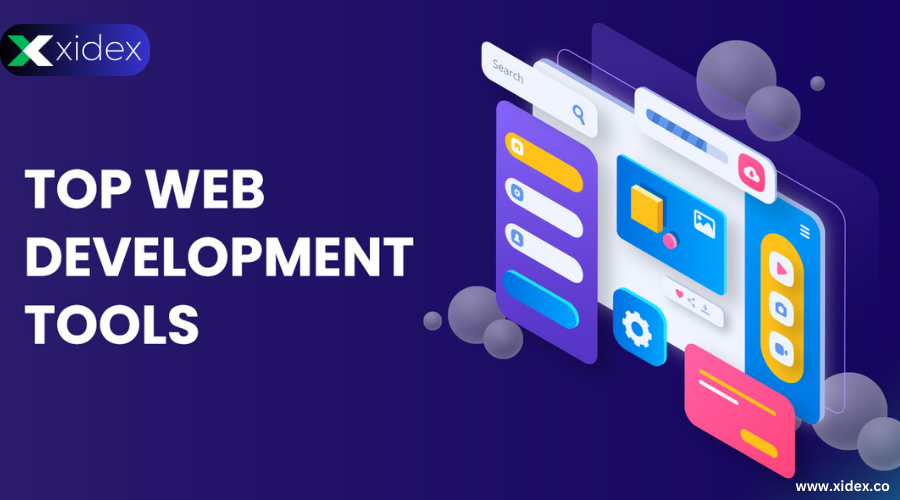In 2023, there are several excellent web application development software options available for developers. Here are six of the best ones
WordPress – Popular Software to Develop Responsive Websites
WordPress is indeed a popular software used to develop responsive websites. It started as a blogging platform but has evolved into a versatile content management system (CMS) that powers a significant portion of the internet.
WordPress provides a user-friendly interface and a vast ecosystem of themes and plugins that allow developers to create responsive and visually appealing websites without extensive coding knowledge. Its responsive design capabilities enable websites to adapt and display properly on various devices, including desktops, tablets, and smartphones.
Key features of WordPress for developing responsive websites include:
- Themes: WordPress offers a wide range of responsive themes that automatically adjust the layout and design to fit different screen sizes. These themes can be customized and provide a solid foundation for building responsive websites.
- Plugins: WordPress has an extensive library of plugins that extend its functionality. There are many plugins available specifically for enhancing responsiveness, such as mobile optimization plugins, responsive image sliders, and responsive menu plugins.
- Customization: WordPress allows developers to customize themes and templates to match their desired look and feel. Developers can modify CSS and HTML code, create custom templates, and utilize theme frameworks to build unique and responsive websites.
- Mobile-Friendly Dashboard: WordPress has a mobile-friendly dashboard that enables website owners and administrators to manage their websites on the go. This ensures that website management tasks can be performed efficiently from mobile devices.
- Mobile Plugins: Apart from responsive design, WordPress also supports mobile plugins that enable additional mobile-specific features, such as touch gestures, mobile-specific content, and mobile app integration.
- SEO-Friendly: WordPress is known for its SEO-friendly architecture, which helps websites rank higher in search engine results. This is crucial for improving the visibility and accessibility of responsive websites across different devices.
WordPress’s popularity stems from its ease of use, flexibility, and the ability to create visually appealing and responsive websites without extensive coding knowledge. However, it’s important to note that while WordPress is an excellent choice for many websites, for more complex or custom projects, a more specialized web development approach may be required.

Bootstrap – Well known HTML, CSS, and JS Library Across the Globe
Bootstrap is a widely recognized HTML, CSS, and JavaScript library used for developing responsive and mobile-first websites and web applications. It was initially developed by Twitter and has since become one of the most popular front-end frameworks in the web development community.
Here are some key points about Bootstrap:
- Responsive Design: Bootstrap’s core feature is its built-in responsive grid system. It provides a flexible grid layout that automatically adjusts and reorganizes content based on the screen size, ensuring that websites and applications look great on different devices.
- Pre-styled Components: Bootstrap offers a rich collection of pre-styled components, such as navigation menus, buttons, forms, alerts, modals, and much more. These components can be easily integrated into projects, saving developers time and effort in designing and styling from scratch.
- Customization Options: While Bootstrap provides a default theme, it also allows extensive customization. Developers can modify the colors, typography, spacing, and other visual aspects to match the specific design requirements of their projects. Additionally, Bootstrap can be compiled with custom CSS to create a unique look and feel.
- JavaScript Plugins: Bootstrap includes a variety of JavaScript plugins that enhance the functionality of websites. These plugins cover areas such as carousels, dropdown menus, modals, tooltips, scrollspy, and more. They are designed to work seamlessly with Bootstrap’s components, making it easier to add interactive elements to a project.
- Community and Documentation: Bootstrap has a large and active community of developers who contribute to its development and provide support. This community-driven approach ensures regular updates, bug fixes, and the availability of numerous resources, tutorials, and documentation.
- Browser Compatibility: Bootstrap is designed to be compatible with modern web browsers, ensuring consistent rendering and functionality across different platforms. It also incorporates responsive design best practices, making it mobile-friendly and accessible.
Bootstrap’s popularity is due to its ease of use, extensive documentation, and the ability to rapidly build responsive websites and applications. It is an excellent choice for developers looking for a robust framework that streamlines the front-end development process and promotes consistency and responsiveness across different devices.
Sublime Text – Best Text Editor to Develop Powerful Applications
Sublime Text is indeed a highly regarded text editor that is favored by many developers for building powerful applications. Here are some reasons why Sublime Text is often considered one of the best text editors:
- Speed and Performance: Sublime Text is known for its exceptional speed and performance. It has a lightweight and efficient architecture that allows for quick loading times, smooth scrolling, and responsiveness, even when handling large codebases.
- Cross-Platform Compatibility: Sublime Text is available for Windows, macOS, and Linux, making it a versatile choice for developers regardless of their operating system preference. It provides a consistent experience across different platforms.
- Extensibility and Customization: Sublime Text can be easily extended and customized through its extensive plugin ecosystem. It offers a rich selection of plugins, allowing developers to enhance their workflow, add new features, and integrate with various tools and languages.
- Powerful Editing Features: Sublime Text provides a wide range of powerful editing features that boost productivity. These include multiple cursors and selections, advanced search and replace functionality, autocompletion, syntax highlighting, and the ability to split and organize views.
- Command Palette and Keyboard Shortcuts: Sublime Text offers a command palette, a quick and convenient way to access various commands and functions. It also supports extensive keyboard shortcuts and allows customization of key bindings, enabling developers to work efficiently without relying heavily on the mouse.
- Stability and Reliability: Sublime Text is known for its stability and reliability. It rarely crashes or experiences performance issues, ensuring a smooth and uninterrupted coding experience.
- Community and Support: Sublime Text has an active community of users who contribute plugins, themes, and support. Developers can find a wealth of resources, tutorials, and discussions to help them get the most out of the editor.
While Sublime Text is a powerful text editor, it’s worth noting that it is not a full-fledged integrated development environment (IDE) like Visual Studio Code or JetBrains’ WebStorm. However, with the help of plugins and customizations, Sublime Text can be tailored to meet the needs of many development projects.
Ultimately, the choice of a text editor depends on personal preferences and project requirements. Many developers appreciate Sublime Text for its speed, simplicity, and extensibility, making it an excellent choice for building powerful applications
Chrome Developer Tools – Best Web Developer Tools Built into Chrome
Chrome Developer Tools is widely recognized as one of the best web developer tools available, built directly into the Google Chrome browser. It provides a comprehensive set of features and functionalities that assist developers in debugging, testing, and optimizing web applications. Here are some reasons why Chrome Developer Tools is highly regarded:
- Inspect and Modify Elements: Chrome Developer Tools allows developers to inspect and modify HTML elements, CSS styles, and the layout of a web page. This feature is invaluable for understanding the structure of a webpage, diagnosing layout issues, and experimenting with different CSS changes in real-time.
- JavaScript Debugging: It provides a powerful JavaScript debugger that allows developers to set breakpoints, step through code, inspect variables, and analyze runtime behavior. This helps in identifying and fixing issues in JavaScript code.
- Network Analysis: Chrome Developer Tools offers a network panel that captures and analyzes network requests made by a web application. Developers can monitor the loading times, examine request and response headers, and identify performance bottlenecks. This is especially useful for optimizing page loading speeds and diagnosing network-related issues.
- Performance Profiling: The performance panel enables developers to record and analyze the performance of a web application. It provides insights into CPU utilization, memory usage, rendering performance, and more. This information helps in identifying and resolving performance bottlenecks to improve the overall efficiency of the application.
- Mobile Device Emulation: Chrome Developer Tools includes a mobile device emulator that allows developers to test and preview web applications on various device profiles. It provides an accurate simulation of different screen sizes, resolutions, and user agent settings, helping developers ensure that their websites are responsive and mobile-friendly.
- Audits and Accessibility: Chrome Developer Tools incorporates auditing capabilities to assess the performance, accessibility, and SEO-friendliness of web applications. It provides recommendations and suggestions for optimizing these aspects, helping developers create more performant and accessible websites.
- Extensions and Customizations: Chrome Developer Tools can be extended through various extensions and customizations, allowing developers to add additional functionality and tailor the tools to their specific needs.
Chrome Developer Tools’ integration with the Chrome browser, its powerful features, and its user-friendly interface make it an invaluable tool for web developers. It provides a comprehensive suite of functionalities for debugging, optimizing, and fine-tuning web applications, making it an essential part of the web development workflow.
GitHub – Best Web Development Repository
GitHub is widely regarded as one of the best web development repositories and collaboration platforms for developers. It offers a range of features and benefits that make it an invaluable tool for web development projects. Here’s why GitHub is highly regarded:
- Version Control: GitHub is built on Git, a distributed version control system. It allows developers to track changes to their code, collaborate with others, and easily roll back to previous versions if needed. Version control is crucial for managing codebase history, collaborating with team members, and ensuring code integrity.
- Collaboration and Social Coding: GitHub facilitates collaboration among developers. It offers features like pull requests, code reviews, issue tracking, and project boards, enabling seamless teamwork. Developers can contribute to projects, provide feedback, and discuss ideas, making it a hub for social coding and community engagement.
- Repository Hosting: GitHub provides a reliable and secure hosting service for code repositories. It offers free public repositories for open-source projects and private repositories for commercial or sensitive projects. GitHub’s robust infrastructure ensures availability and backups, eliminating the need for developers to set up their own hosting environments.
- Documentation and Wiki: GitHub allows developers to create project documentation and wikis. This feature is invaluable for maintaining project information, documenting APIs, providing tutorials, and sharing knowledge with the development community.
- Issue Tracking and Bug Reporting: GitHub provides a built-in issue tracking system, making it easy to report and manage bugs, feature requests, and other project-related issues. Developers can create, assign, and track issues, ensuring a streamlined workflow for bug fixing and project management.
- Integration with CI/CD Tools: GitHub seamlessly integrates with popular continuous integration and continuous deployment (CI/CD) tools like Jenkins, Travis CI, and CircleCI. This integration enables automated testing, building, and deployment of web applications, streamlining the development process and ensuring code quality.
- Open Source Community: GitHub has a thriving open-source community, with millions of developers contributing to projects across various domains. It serves as a platform for discovering, exploring, and contributing to a vast array of open-source web development projects, fostering collaboration and knowledge sharing.
GitHub’s popularity among developers is a testament to its robust feature set, ease of use, and the power it brings to the web development workflow. Whether for personal projects, team collaborations, or contributing to open-source initiatives, GitHub provides a centralized and efficient repository for managing and collaborating on web development projects
Adobe XD – Top Web Design Tool for Creating Prototypes
Adobe XD is indeed recognized as one of the top web design tools for creating prototypes. It is a powerful and user-friendly design and prototyping tool developed by Adobe. Here are some reasons why Adobe XD is highly regarded for web design and prototyping:
- Design and Prototyping in One Tool: Adobe XD combines design and prototyping capabilities in a single application. It allows designers to create visual designs for web interfaces and then easily transform them into interactive prototypes without the need for additional software.
- Responsive Design: Adobe XD supports responsive design, allowing designers to create designs that adapt and scale seamlessly across different screen sizes and devices. Design elements can be set to auto-resize, ensuring consistency and fluidity in the user interface.
- Interactive Prototyping: With Adobe XD, designers can create interactive prototypes that simulate user interactions and flows. This enables stakeholders and clients to experience and provide feedback on the user experience before development begins, saving time and effort in the iteration process.
- Components and Repeat Grids: Adobe XD offers features like components and repeat grids, which enhance efficiency in the design process. Components allow designers to create reusable elements, such as headers or buttons, and update them across the entire design with a single edit. Repeat grids enable designers to quickly duplicate and adjust content, such as lists or grids.
- Design Systems and Style Guides: Adobe XD supports the creation and management of design systems and style guides. Designers can define and maintain a library of reusable components, styles, and assets, ensuring consistency throughout the design process and promoting collaboration across teams.
- Collaboration and Sharing: Adobe XD allows designers to share their designs and prototypes with stakeholders and clients for review and feedback. Designers can generate shareable links or invite collaborators to provide comments directly within the design, streamlining the communication and review process.
- Integration with Adobe Creative Cloud: Adobe XD seamlessly integrates with other Adobe Creative Cloud applications like Photoshop, Illustrator, and After Effects. This integration enables designers to import assets and designs from other Adobe tools and further enhance their designs with the full power of the Creative Cloud ecosystem.
Adobe XD’s user-friendly interface, powerful prototyping capabilities, and seamless integration with other Adobe tools make it a popular choice among web designers for creating interactive prototypes. It simplifies the design-to-prototype workflow, promotes collaboration, and enables designers to create engaging and user-centric web experiences.
FAQ About Web Application Development Software
Certainly! Here are some frequently asked questions about web application development software:
- What is web application development software? Web application development software refers to tools, frameworks, and platforms that assist developers in building web-based applications. These software solutions provide a range of features and functionalities, such as code editors, debugging tools, libraries, and deployment options, to streamline the development process.
- What are the key features to consider in web application development software? Some key features to consider in web application development software include a user-friendly interface, support for multiple programming languages, robust debugging and testing capabilities, efficient code management and version control, responsive design options, integration with databases and APIs, and deployment options for different hosting environments.
- Which programming languages are commonly supported by web application development software? Web application development software typically supports popular programming languages such as JavaScript, HTML, CSS, Python, Ruby, PHP, Java, and .NET. The choice of programming language depends on the specific requirements of the project and the preferences of the development team.
- What are some examples of web application development software? Some popular examples of web application development software include Visual Studio Code, Sublime Text, Atom, Eclipse, NetBeans, PhpStorm, WebStorm, IntelliJ IDEA, Angular, React, Vue.js, Laravel, Django, Ruby on Rails, and ASP.NET.
- Are there web application development software specifically for non-technical users? Yes, there are web application development software tools that cater to non-technical users who want to create web applications without extensive coding knowledge. These tools typically provide a visual interface, drag-and-drop functionality, and pre-built templates to simplify the development process. Examples of such tools include WordPress, Wix, Squarespace, and Bubble.
- How do I choose the right web application development software for my project? When choosing web application development software, consider factors such as your project requirements, programming language preferences, development team’s expertise, scalability needs, available resources, budget, and support/documentation provided by the software. It’s also beneficial to try out different tools through trials or demos to assess their suitability for your specific project.
Remember, the choice of web application development software depends on the nature of your project, your development goals, and the preferences and expertise of your team
Read More : VR Application Development: A Guide for Enterprises





